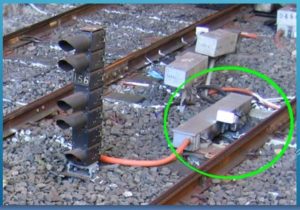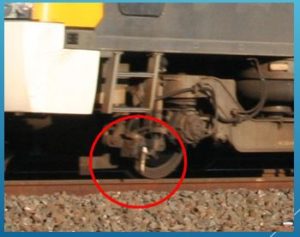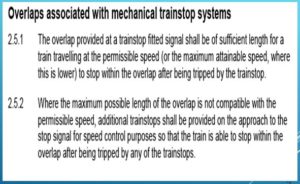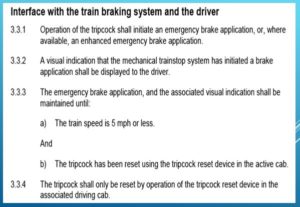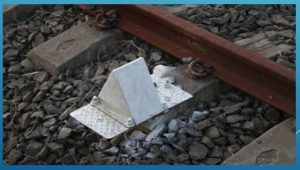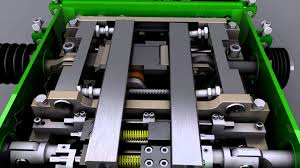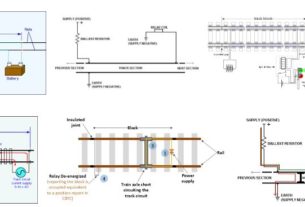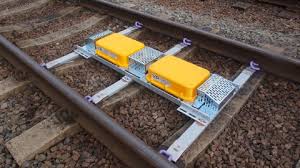Railway Signalling Train Stop Equipment Presentation
Railway Signalling Train Stop Equipment Presentation What is a Train stop?
The train stop is a train protection device that automatically stops a train if it attempts to pass a signal at danger or (in some applications) if it attempts to pass at an excessive speed on the approach to all terminal and bay platforms.
Raised (or effective) State (of train stop)
The Status of a train stops such that it will not initiate a brake application on a train passing the train stop.
Lowered (or effective) State (of train stop)
The Status of a train stops such that it will not initiate a brake application on a train passing the train stop.
Principle:
The train stop system operates on the principle of a mechanical interface between track-mounted train stop arm and vehicle-mounted tripcocks. When the tripcock on the train is deflected by a raised train stop arm, it automatically initiates an emergency brake application.
Basic operation:
The train stop system comprises two basic components:
One is the trip arm mechanism, mounted on the ground adjacent to the rail, which essentially consists of a spring-loaded arm connected to an electric motor.
The other is the train-mounted trip cock, which is connected either directly or electrically to the train’s braking system.
When the signalling system determines it is safe for the train to proceed, the motor drives the trip arm down to the lowered position. The spring ensures that the trip arm is raised in all other situations. If a train attempts to pass the signal with the trip arm in the raised position, the trip arm makes mechanical contact with the trip cock on the train, causing the train’s brakes to be automatically applied, thereby bringing the train to a halt.
Wayside trip arms are adjusted so that they rise to a point approximately 2½ inches (about 6 centimetres) above the top of the running rail when in the stop position, and lower to approximately 1 inch (2.5 centimetres) below the top of the running rail when clear.
The time taken for the arm to rise or be lowered is approximately two seconds.
Types of Train stops:
There are three types of train stops:
Trip stop – stops train trying to pass a red signal
Timed train stop – stops train moving too fast
Fixed train stop – prevents any trains from passing a point
Trip stops:
The trip arm is raised whenever the signal is not displaying a proceed aspect. If a train tries to pass the signal, the trip cock on the train strikes the raised trip arm and the train is brought to a halt. When the signal indicates it is safe to proceed (clear or cautious), the trip arm is lowered, and a train is able to proceed without further hindrance. In some cases, the trip arm will not be lowered when the signal to which it applies is exhibiting a proceed indication, e.g. when subsidiary signals are cleared, forcing a train to trip before proceeding, thus ensuring that movements are conducted at safe speeds.
Timed train stops:
With a timed train stop, the trip arm stays raised when the train approaches at a speed higher than the one that is set and trips the train to a stop. If the train approaches at a speed equal to or lower than the set speed, the trip arm lowers before the train arrives, and the train is able to proceed without further hindrance.
Fixed train stops:
With fixed train stops, the trip arm cannot be lowered. Fixed stops are positioned close to the end of a dead-end track, to stop a train before it runs out of track. They may also be used at the end of track sections beyond which certain trains should not pass e.g. storage sidings.
Mechanical Working Of Train stop:
When a signal displays the proceed aspect the train stop head is lowered from the raised position by air being admitted to a cylinder. This action is common for all train stops, which causes the head to lower to a position below the train tripcock line. This lowering of the train stop head also applies compression to a spring or springs which are part of the train stop mechanism. The head is maintained all the time in the lowered position when the signal displays proceed aspect.
When the signal returns to danger the air supply is removed from the cylinder, the compressed spring or springs then mechanically force the head back to the raised position.
Railway Signalling Train Stop Equipment Mechanical Types Of Train stop:
LER ( London Electric Railway)
DR ( District Railway)
CLR ( Central London Railway)
“H” O ( “H” outside)
“H” T ( “H” Tube tunnel)
“J” ( Outdoor type self-lubricating)
“K” ( Tube tunnel type self-lubricating)
Railway Group Standard
GERT8018 Iss 2_mechanical train stop
Railway Signalling Train Stop Equipment meaning
Railway Signalling Train Stop Equipment Automatic train stop

